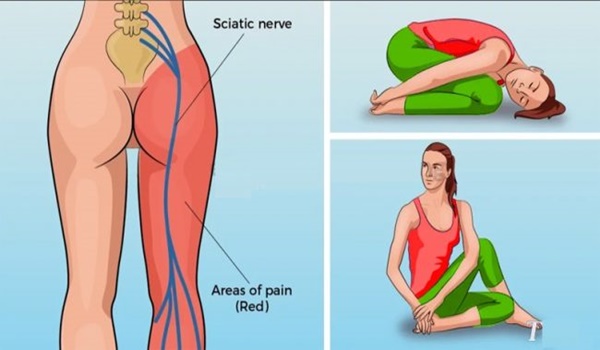The benefits of yoga are countless, both, for the body and mind. As a regular exercise, yoga boosts flexibility, muscle tone, and strength, and helps weight loss. It protects from injury and improves our athletic performance, leaving us full of energy and vitality.
Therefore, it is one of the most effective ways to combat the symptoms of sciatica pain. If you have ever suffered from sciatica pain, you already know that it is one of the most painful conditions one can experience.
The sciatic nerve is the longest in the body, stretching from the base of the spine, through the muscles of the thighs, and extending to the muscles of the feet.
The sciatic nerve runs through a small, but significant muscle deep within the hip, called the piriformis. When tension builds up within it, it compresses and irritates the nerve, leading to unbearable pain.
Apart from the pain along the sciatic nerve, sciatica pain is often accompanied by other unpleasant symptoms like stiffness in the legs and feet, tingling and pinching in the leg, hip pain, numbness or difficulty to move the leg or foot, reduced reflexes in the knee, and weakness which causes buckles of the knees when one gets up from sitting.
This condition is often a result of a herniation in the lumbar spine.
Yoga is a proven and effective way to manage sciatica pain, so here are 8 poses you should perform daily in case you suffer from it:
1. The Standing Back Twist

Place a foot onto a chair, put the outer arm on a raised knee, and the other arm on the other side. Rotate the upper body while keeping the hips together. Hold for 30 seconds, and repeat on the other side.
2. The Knee Raise

Start in a supine position on the back. Pull a knee to the chest, with the leg still straight, and the toes up. Press the knee, pull with the hands, and keep the shoulders on the floor.
3. The Two Knee Twist

Lie on the back, and with the help of your hands, form the capital letter “T.” Keep the shoulders on the floor, turn the knees to one side, and hold for a minute. Repeat on the other side.
4. The Single Knee Twist

Lie on the back with one leg straight, and one knee bent at a 90 ° angle. Place the opposite arm on that knee. Stretch the hand on the floor to the opposite side, and keep both shoulders on the floor.
5. The Twisted Lunge

In a standing position, step with one leg forward, bend the knee and keep the other leg at the back. Lunge down until your legs form two right angles, and then twist the torso as far left as you can. Hold for 30 seconds, and repeat on the other side.
6. The Seated Twist

Start in a sitting position, with the feet straight in front of you. Bend the knee, and place it on the outside of the other knee. Keep one hand on the floor behind you, with the opposite elbow on the outside of the bent knee. On the exhale, move deeper into the twist while looking over your right shoulder.
7. The Cat Pose

Start on all fours, and then lift the chest pulling your shoulders back. Inhale deeply, and hold thus for 10 seconds. Then, straighten the back, tuck the chin into your chest and lift your back. Hold for another 10 seconds and release.
8. Child’s Pose

Lower your body to the arms and knees, lean against the heels, and keep the hands on the floor in front of you. Remain for as long as you feel comfortable.
For best results, perform these yoga poses in the morning before you go to work, or in the evening before you go to sleep. You will feel the improvements very soon!
Yet, yoga might not be appropriate for every cause of sciatica, so before you try these poses, make sure you seek a diagnosis from a doctor.
Apart from stretching and exercising, experts also suggest alternating heat and ice therapy. You should keep an ice pack on the painful area for 15 minutes once every hour, and then apply heat for 15 minutes every two hours. Ice fights the inflammation, while the heat encourages blood flow to the painful area.
This therapy also soothes muscle spasms that can accompany sciatica pain.
Sources: www.spineuniverse.com


